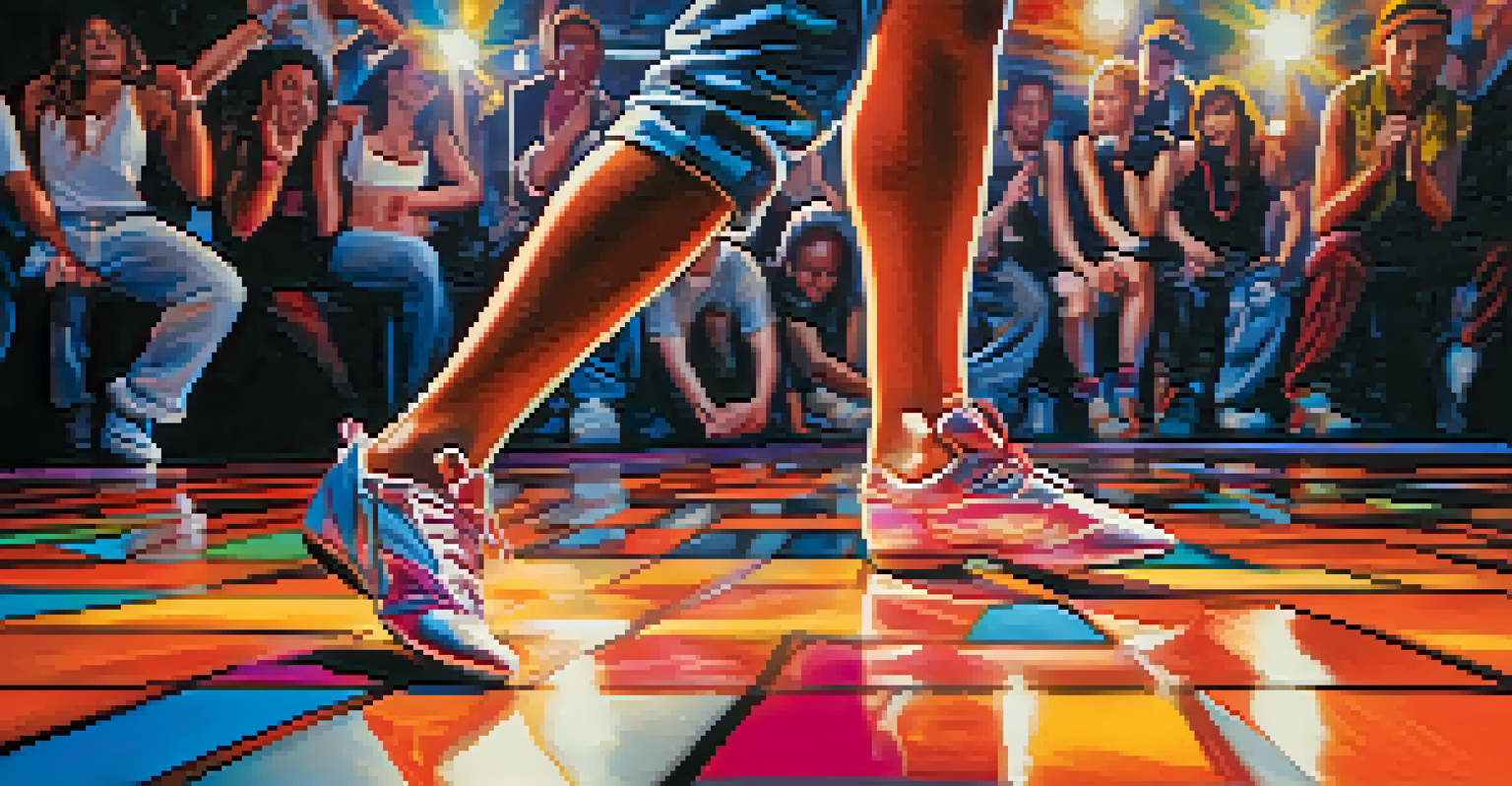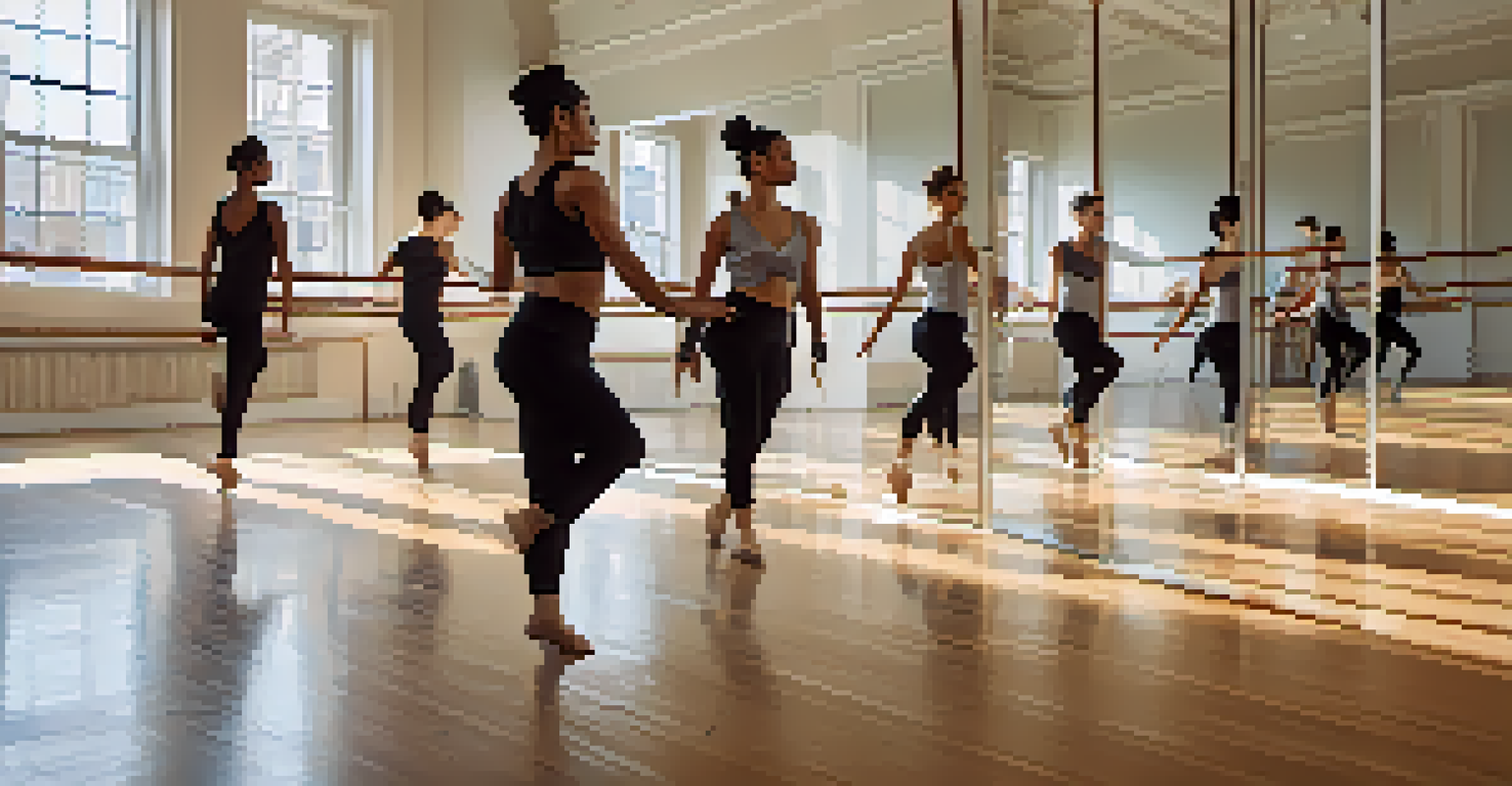Hip-Hop Dance: A Platform for Gender Expression and Identity

Understanding Hip-Hop Dance and Its Cultural Roots
Hip-hop dance emerged in the late 1970s as part of a cultural movement that included music, fashion, and art. It's deeply rooted in African American and Latino communities, embodying a spirit of rebellion and self-expression. The dance style has evolved, incorporating various influences and techniques, making it a dynamic art form that continues to resonate with people today.
Dance is a conversation between the body and the spirit.
At its core, hip-hop dance is about storytelling and identity. Dancers use their bodies to convey emotions and narratives, often reflecting their personal experiences and cultural backgrounds. This makes hip-hop not just a dance style, but a platform for individuals to express who they are and where they come from.
As hip-hop gained popularity, it began to transcend cultural boundaries, attracting dancers from various backgrounds. This inclusivity has led to a rich tapestry of styles and interpretations, allowing each dancer to bring their unique perspective to the dance floor.
The Role of Gender in Hip-Hop Dance
Gender plays a crucial role in hip-hop dance, influencing how individuals express themselves and interact with the community. Traditionally, hip-hop has been male-dominated, but this is changing as more women and non-binary dancers make their mark. This shift challenges stereotypes and opens up conversations about gender norms within the dance community.

Dancers often use hip-hop as a means to challenge preconceived notions about femininity and masculinity. For instance, female dancers might incorporate powerful, aggressive movements typically associated with male dancers, asserting their strength and presence. Likewise, male dancers might explore more fluid or delicate styles, pushing against traditional expectations.
Hip-Hop Dance as Self-Expression
Hip-hop dance serves as a powerful platform for individuals to express their identities and personal narratives through movement.
This fluidity in gender expression within hip-hop dance not only enriches the art form but also allows dancers to redefine their identities. By breaking down barriers, hip-hop creates a space where everyone can feel free to explore and express their gender in ways that feel authentic to them.
Hip-Hop Dance as a Safe Space for Self-Expression
For many dancers, hip-hop serves as a safe haven where they can be themselves without fear of judgment. This environment fosters creativity and encourages individuals to explore their identities openly. In classes and battles, dancers often find acceptance and support from their peers, which can be incredibly empowering.
The dance is a poem of which each movement is a word.
The sense of community in hip-hop dance is vital. It allows individuals to connect with others who share similar experiences and struggles, making it easier to express personal stories through movement. This shared understanding creates bonds that transcend gender, age, and background, building a strong support network.
Ultimately, this safe space nurtures self-discovery, helping dancers find their voices and explore their identities more deeply. Hip-hop dance becomes a canvas for personal expression, allowing individuals to showcase their uniqueness and celebrate their differences.
Influence of Hip-Hop Icons on Gender Expression
Hip-hop icons have played a significant role in shaping the conversation around gender expression. Artists like Missy Elliott and Lil' Kim have pushed boundaries, using their platforms to challenge gender norms and advocate for self-expression. Their bold performances and unique styles inspire dancers to embrace their individuality unapologetically.
Moreover, male artists like Jaden Smith and Frank Ocean have expanded the dialogue around masculinity, promoting a more fluid approach to gender. Their willingness to experiment with style and presentation encourages dancers to explore their identities in ways that resonate with them personally, regardless of societal expectations.
Gender Fluidity in Hip-Hop
The evolution of hip-hop dance encourages fluidity in gender expression, allowing dancers to challenge traditional norms and explore their identities.
The influence of these icons highlights the power of hip-hop as a medium for change, illustrating that dance is not just about movement—it's also about the messages conveyed through that movement. By embracing diverse representations, hip-hop dance fosters an environment where all identities can flourish.
The Intersection of Hip-Hop Dance and LGBTQ+ Representation
Hip-hop dance has increasingly become a platform for LGBTQ+ representation, providing a voice to individuals who often feel marginalized. Many LGBTQ+ dancers use hip-hop to express their experiences, challenges, and triumphs, bringing visibility to their narratives within the larger dance community. This representation is crucial for fostering understanding and acceptance.
Dance battles and showcases often feature LGBTQ+ artists who challenge traditional gender roles through their performances. By showcasing their talent and creativity, these dancers empower others within the community to embrace their identities and express themselves freely. The vibrancy of LGBTQ+ culture adds depth and richness to the hip-hop scene.
As the hip-hop community continues to evolve, it becomes increasingly inclusive, embracing diverse identities and experiences. This shift not only benefits LGBTQ+ dancers but also enriches the entire dance culture, promoting a broader understanding of gender and identity.
Choreography as a Tool for Gender Exploration
Choreography in hip-hop dance is a powerful tool for exploring and expressing gender. Dancers often create routines that reflect their personal journeys and identities, using movement to articulate their feelings and experiences. This process allows for a deeper understanding of gender and the complexities that come with it.
By experimenting with different styles and techniques, dancers can challenge traditional norms and expectations. For instance, a choreographer might blend feminine and masculine movements to create a piece that speaks to the fluidity of gender. This kind of innovation not only expands the vocabulary of hip-hop dance but also encourages others to think critically about gender representation.
LGBTQ+ Representation in Hip-Hop
Hip-hop dance increasingly provides visibility and a voice for LGBTQ+ individuals, promoting understanding and acceptance within the dance community.
Ultimately, choreography becomes a form of storytelling, allowing dancers to communicate their truths and connect with audiences on a visceral level. Through this expressive medium, hip-hop dance fosters an ongoing dialogue about gender identity and encourages continuous exploration.
The Future of Gender Expression in Hip-Hop Dance
As hip-hop dance continues to evolve, the conversation around gender expression is expanding as well. New generations of dancers are embracing inclusivity, pushing for a more comprehensive understanding of gender beyond the binary. This shift signifies a growing recognition that identity is multifaceted and should be celebrated.
With social media amplifying diverse voices, more dancers are sharing their stories and experiences, fostering a sense of community and connection. This visibility is crucial for inspiring others to explore their identities and express themselves through dance. The digital age empowers individuals to find their niche within the hip-hop community, regardless of gender.

Looking ahead, the future of gender expression in hip-hop dance appears bright. As the dance form continues to adapt and grow, it will likely serve as a platform for even more diverse voices, celebrating the richness of human identity and encouraging everyone to dance to the rhythm of their own truth.